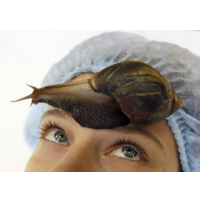Giant African Snails Pay Unwanted Call on Port of Oakland
 (photo: Reuters)
(photo: Reuters)
There is no end to the ways disaster can be visited upon Californians—earthquake, drought, El Nino, polluted air, electric grid failure, industrial-tainted water supply, nuclear plant accident, overheated ocean, rising tides and lower water table.
The San Francisco Chronicle would like to add Lissachatina fulica, giant African snails, to the list.
Two of the monstrously large creatures (8 inches long, 5 inches wide) were found on wooden pallets from American Samoa at the Port of Oakland this month, raising the spectre of a voracious pest with no known predators set loose upon California which, in the words of the Chronicle, “eats crops and homes.”
U.S. Customs and Border Protection agents said this is the second time in two months, snails have been found at the port.
The snails are a world-class invasive pest. They like 500 kinds of plants, but their varied tastes include stucco, plaster and paint. They live for 10 years and carry a parasite that causes eosinophilic meningitis in humans. (Wear gloves when handling them.)
They are considered a delicacy by some, a beauty treatment in Russia and delightful pets by others. Snails4You in Great Britain (they accept PayPal) considers giant African snails a must-buy:
“These magnificent creatures are unusual to say the least, and certainly a great talking point! Although these snails are classed as an exotic pet, their popularity in this country is growing fast. They couldn't be easier to look after either, compared to some more traditional pets.”
The Oakland specimens, which were found with lots of eggs by agents, were sent to the U.S. Department of Agriculture (USDA) for testing.
This is not their first near-introduction to California. They were first spotted in the country in the 1940s at San Pedro in Southern California. More than 50 interceptions at California ports were reported between 1948 and 1958. They have also been found in the Great Lake states of Wisconsin, Michigan and Ohio.
Last July, Customs intercepted two picnic baskets filled with 67 snails at Los Angeles International Airport (LAX). A Nigerian man declared them as being for human consumption and they were headed for San Dimas. They did not get there.
Live giant African snails are illegal in the United States. One can’t say for certain someone hasn’t brought a snail or two into the state, but they tend to make their presence known eventually.
They were discovered in Miami in September 2011 and have wreaked havoc in the county. More than 141,000 have been found in 26 locations, although they haven’t impacted the state’s $100-billion-a-year farm industry. Snails like citrus and most row crops.
It was a return visit for the snails, which appeared in Florida in the 1960s. A boy was suspected of having brought three of them in as pets from Hawaii. Grandma set them free in the garden, and it took 10 years to eradicate the ensuing infestation that numbered at least 18,000.
Although the USDA website says Florida is the only state with a giant African snail population, the slimy creatures have recently turned up in other states. The USDA seized more than 1,200 live snails from a person in Georgia who was selling them illegally around the country. They apparently came from Great Britain.
The department nabbed 200 more in the possession of a Long Island, New York buyer. More buyers were located in Indiana and Pennsylvania.
–Ken Broder
To Learn More:
Giant African Snail Eats Crops and Homes, and It’s Moving Our Way (by Chip Johnson, San Francisco Chronicle)
More Than 1,200 Illegal Giant African Snails Seized by USDA Since June (by Mary Clare Jalonick, Associated Press)
67 Giant African Snails, Meant for Human Consumption, Seized at LAX (by Veronica Rocha, Los Angeles Times)
For Beauty: Giant African Land Snails on Your Face (Geekologie)
Giant (East) African Snail (Achatina fulica) (by Heather Stokes, Columbia University)
- Top Stories
- Controversies
- Where is the Money Going?
- California and the Nation
- Appointments and Resignations
- Unusual News
- Latest News
- California Forbids U.S. Immigration Agents from Pretending to be Police
- California Lawmakers Urged to Strip “Self-Dealing” Tax Board of Its Duties
- Big Oil’s Grip on California
- Santa Cruz Police See Homeland Security Betrayal in Use of Gang Roundup as Cover for Immigration Raid
- Oil Companies Face Deadline to Stop Polluting California Groundwater





